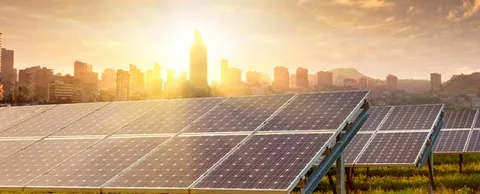
You’re likely under increasing pressure to meet increasingly difficult climate goals. But success doesn’t have to be prohibitively expensive. In fact, as places like California and Charlotte demonstrate, you can actually save millions of dollars. You heard me right. You can make the environment better while saving money.
As you’ll read below, solar panels may seem expensive, but they played a significant role in saving California $192 million. First are the new sources of clean power. Next are analytics that stretch the overall energy supply. For instance, the state cancelled 13 transmission line projects. It no longer needed to ship power long distances when it could generate it locally. It’s an approach that’s working in several cities as well.
The message: You can make progress toward your climate goals AND improve your bottom line. Here are three ideas to get you started. — Kevin Ebi
1. Reduce or eliminate “old school” projects that are no longer needed
A powerful combination of energy efficiency and new clean energy sources — mainly solar — has eliminated the need for 13 transmission projects that were on California’s drawing board. Total savings: $192 million. And that’s just the beginning. Southern California Edison plans to bring 50 megawatts of solar power online next year, eliminating the need to upgrade two substations in Orange County.
But solar power is only part of the equation. California has discovered that residents are becoming active participants in the power grid through electric vehicles, energy storage, and so on. Those private investments can have public benefits. Decentralizing the grid can pose its own challenges, but the state has been working hard to map out the new resources and figure out how leverage them.
There’s a lot in it for consumers. Through cutting the need for expensive utility upgrades, they pay less for their power.
2. Use analytics to save more power
Conservation can also play a sizable role in reducing costs. Council Lead Partner SAS profiled Charlotte, North Carolina, which cut its energy bill by $18 million by cutting consumption more than 17%. Most buildings in the downtown core agreed to use meters and kiosks to gather real-time usage information and educate people on ways to conserve.
Four years into the project, the city has learned a lesson: How you talk about analytics is as important as the data itself. The city uses open data to power a portal giving anyone the ability to look for savings. Researchers at UNC Charlotte are also studying the data.
But putting a data scientist in a room with a city manager or business person doesn’t always deliver results. It’s often more effective to have someone who understands data and city/business needs who can be in the middle and serve as a translator. Council Lead Partner Schneider Electric says that’s even more important today since businesses are paying more attention to their energy consumption, so more facility managers are actually interacting with high-level executives and need to be able to speak that language.
3. Learn what motivates people (it’s not just rebates)
CPS Energy says don’t get too hung up on costs. A lot of times, utilities think that people will want to do something because it costs less and are surprised when the consumer engagement isn’t there. Giving control and choice are often much more motivating factors.
“Customers don’t always adopt what utilities think are the obvious solutions,” Matthew Croucher, CPS Energy’s Director of Demand-Side Analytics, told SAS. “Time and time again, the customer research suggests that while saving money is important for customers, what customers are all focused on is the ability to control their usage and comfort. It’s about more than just rebates. How do we optimally deploy our programs so both the customer and the utility see value, and what services do customers want now and in the next 10-20 years?”
How to get started
Cities cannot function without energy. The Energy chapter of the Council’s Smart Cities Readiness Guide shows you how to use connectivity, interoperability, data and analytics to make your power grid more resilient and sustainable.



